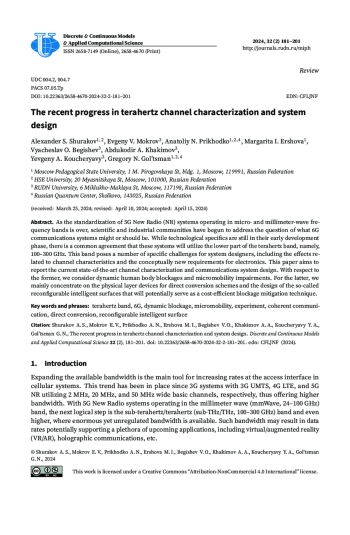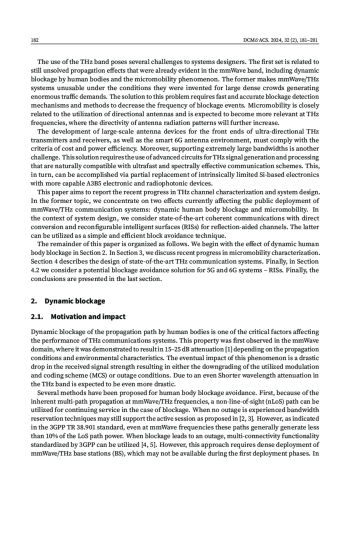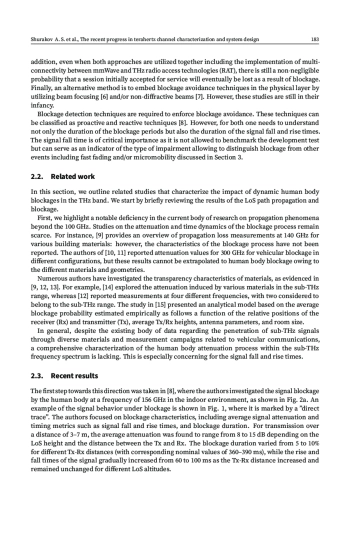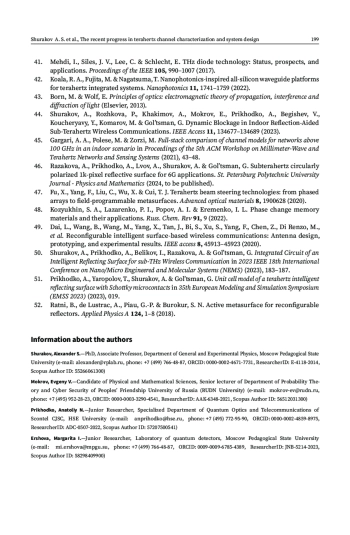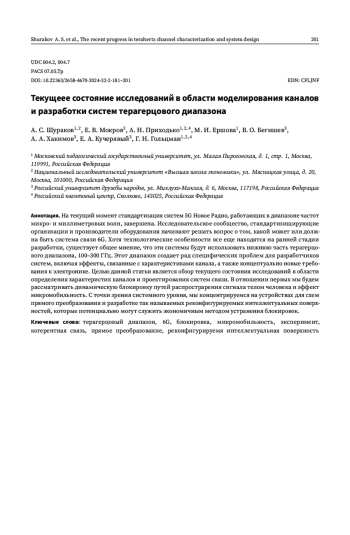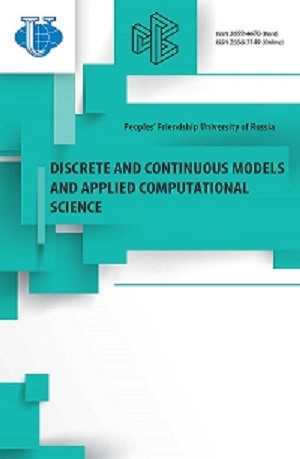As the standardization of 5G New Radio (NR) systems operating in micro- and millimeter-wave frequency bands is over, scientific and industrial communities have begun to address the question of what 6G communications systems might or should be. While technological specifics are still in their early development phase, there is a common agreement that these systems will utilize the lower part of the terahertz band, namely, 100–300 GHz. This band poses a number of specific challenges for system designers, including the effects related to channel characteristics and the conceptually new requirements for electronics. This paper aims to report the current state-of-the-art channel characterization and communications system design. With respect to the former, we consider dynamic human body blockages and micromobility impairments. For the latter, we mainly concentrate on the physical layer devices for direct conversion schemes and the design of the so-called reconfigurable intelligent surfaces that will potentially serve as a cost-efficient blockage mitigation technique.
Идентификаторы и классификаторы
Expanding the available bandwidth is the main tool for increasing rates at the access interface in cellular systems. This trend has been in place since 3G systems with 3G UMTS, 4G LTE, and 5G NR utilizing 2 MHz, 20 MHz, and 50 MHz wide basic channels, respectively, thus offering higher bandwidth. With 5G New Radio systems operating in the millimeter wave (mmWave, 24–100 GHz) band, the next logical step is the sub-terahertz/terahertz (sub-THz/THz, 100–300 GHz) band and even higher, where enormous yet unregulated bandwidth is available. Such bandwidth may result in data rates potentially supporting a plethora of upcoming applications, including virtual/augmented reality (VR/AR), holographic communications, etc.
Список литературы
1. Park, J.-J., Lee, J., Liang, J., Kim, K.-W., Lee, K.-C. & Kim, M.-D. Millimeter wave vehicular blockage characteristics based on 28 GHz measurements in 2017 IEEE 86th Vehicular Technology Conference (VTC-Fall) (2017), 1–5.
2. Begishev, V., Sopin, E., Moltchanov, D., Kovalchukov, R., Samuylov, A., Andreev, S., Koucheryavy, Y. & Samouylov, K. Joint use of guard capacity and multiconnectivity for improved session continuity in millimeter-wave 5G NR systems. IEEE Transactions on Vehicular Technology 70, 2657–2672 (2021).
3. Kovalchukov, R., Moltchanov, D., Begishev, V., Samuylov, A., Andreev, S., Koucheryavy, Y. & Samouylov, K. Improved session continuity in 5G NR with joint use of multi-connectivity and guard bandwidth in 2018 IEEE Global Communications Conference (GLOBECOM) (2018), 1–7.
4. Begishev, V., Sopin, E., Moltchanov, D., Pirmagomedov, R., Samuylov, A., Andreev, S., Koucheryavy, Y. & Samouylov, K. Performance analysis of multi-band microwave and millimeter-wave operation in 5G NR systems. IEEE Transactions on Wireless Communications 20, 3475–3490 (2021).
5. Sopin, E., Moltchanov, D., Daraseliya, A., Koucheryavy, Y. & Gaidamaka, Y. User association and multi-connectivity strategies in joint terahertz and millimeter wave 6G systems. IEEE Transactions on Vehicular Technology 71, 12765–12781 (2022).
6. Zhang, H., Shlezinger, N., Guidi, F., Dardari, D., Imani, M. F. & Eldar, Y. C. Beam focusing for near-field multiuser MIMO communications. IEEE Transactions on Wireless Communications 21, 7476–7490 (2022).
7. Durnin, J., Miceli, J. & Eberly, J. H. Comparison of Bessel and Gaussian beams. Optics letters 13, 79–80 (1988).
8. Shurakov, A., Moltchanov, D., Prikhodko, A., Khakimov, A., Mokrov, E., Begishev, V., Belikov, I., Koucheryavy, Y. & Gol’tsman, G. Empirical blockage characterization and detection in indoor sub-THz communications. Computer Communications 201, 48–58. doi:10.1016/j.comcom.2023. 01.017 (2023).
9. Xing, Y. & Rappaport, T. S. Propagation measurement system and approach at 140 GHz-moving to 6G and above 100 GHz in 2018 IEEE global communications Conference (GLOBECOM) (2018), 1–6.
10. Eckhardt, J. M., Petrov, V., Moltchanov, D., Koucheryavy, Y. & Kürner, T. Channel Measurements and Modeling for Low-Terahertz Band Vehicular Communications. IEEE Journal on Selected Areas in Communications 39, 1590–1603 (2021).
11. Petrov, V., Eckhardt, J. M., Moltchanov, D., Koucheryavy, Y. & Kurner, T. Measurements of reflection and penetration losses in low terahertz band vehicular communications in 2020 14th European Conference on Antennas and Propagation (EuCAP) (2020), 1–5.
12. Du, K., Ozdemir, O., Erden, F. & Guvenc, I. Sub-Terahertz and mmWave Penetration Loss Measurements for Indoor Environments. arXiv preprint arXiv:2103.02745 (2021).
13. Kokkoniemi, J., Lehtomäki, J., Petrov, V., Moltchanov, D. & Juntti, M. Frequency domain penetration loss in the terahertz band in 2016 Global Symposium on Millimeter Waves (GSMM) & ESA Workshop on Millimetre-Wave Technology and Applications (2016), 1–4.
14. Xing, Y. & Rappaport, T. S. Propagation measurement system and approach at 140 GHz-moving to 6G and above 100 GHz in 2018 IEEE global communications Conference (GLOBECOM) (2018), 1–6.
15. Bilgin, B. A., Ramezani, H. & Akan, O. B. Human blockage model for indoor terahertz band communication in 2019 IEEE International Conference on Communications Workshops (ICC Workshops) (2019), 1–6.
16. Shurakov, A., Rozhkova, P., Khakimov, A., Mokrov, E., Prikhodko, A., Begishev, V., Koucheryavy, Y., Komarov, M. & Gol’tsman, G. Dynamic Blockage in Indoor Reflection-Aided Sub-Terahertz Wireless Communications. IEEE Access 11, 134677–134689. doi:10.1109/ACCESS. 2023.3337050 (2023).
17. Ostrikova, D., Beschastnyi, V., Moltchanov, D., Gaidamaka, Y., Koucheryavy, Y. & Samouylov, K. System-level analysis of energy and performance trade-offs in mmWave 5G NR systems. IEEE Transactions on Wireless Communications (2023).
18. Balanis, C. Antenna theory: analysis and design. Microstrip Antennas, John Wiley & Sons (2005).
19. Ichkov, A., Gehring, I., Mähönen, P. & Simić, L. Millimeter-wave beam misalignment effects of small-and large-scale user mobility based on urban measurements in Proceedings of the 5th ACM Workshop on Millimeter-Wave and Terahertz Networks and Sensing Systems (2021), 13–18.
20. Petrov, V., Moltchanov, D., Koucheryavy, Y. & Jornet, J. M. The effect of small-scale mobility on terahertz band communications in Proceedings of the 5th ACM International Conference on Nanoscale Computing and Communication (2018), 1–2.
21. Petrov, V., Moltchanov, D., Koucheryavy, Y. & Jornet, J. M. Capacity and outage of terahertz communications with user micro-mobility and beam misalignment. IEEE Transactions on Vehicular Technology 69, 6822–6827 (2020).
22. Stepanov, N., Turlikov, A., Begishev, V., Koucheryavy, Y. & Moltchanov, D. Accuracy assessment of user micromobility models for thz cellular systems in Proceedings of the 5th ACM Workshop on Millimeter-Wave and Terahertz Networks and Sensing Systems (2021), 37–42.
23. Stepanov, N., Moltchanov, D., Begishev, V., Turlikov, A. & Koucheryavy, Y. Statistical analysis and modeling of user micromobility for THz cellular communications. IEEE Transactions on Vehicular Technology 71, 725–738 (2021).
24. Moltchanov, D., Gaidamaka, Y., Ostrikova, D., Beschastnyi, V., Koucheryavy, Y. & Samouylov, K. Ergodic outage and capacity of terahertz systems under micromobility and blockage impairments. IEEE Transactions on Wireless Communications 21, 3024–3039 (2021).
25. Dugaeva, S., Begishev, V., Mokrov, E. & Samouylov, K. Using Motion Sensors For Improved Beam Tracking in THz Communications with User Micromobility in 2022 International Conference on Modern Network Technologies (MoNeTec) (2022), 1–8.
26. Dugaeva, S., Begishev, V. & Stepanov, N. Utilization of Machine Learning Algorithms to Identify User Applications in International Conference on Distributed Computer and Communication Networks (2023), 410–422.
27. Du Preez, J., Sinha, S. & Sengupta, K. SiGe and CMOS technology for state-of-the-art millimeterwave transceivers. IEEE Access (2023).
28. Jia, S., Lo, M.-C., Zhang, L., Ozolins, O., Udalcovs, A., Kong, D., Pang, X., Guzman, R., Yu, X., Xiao, S., et al. Integrated dual-laser photonic chip for high-purity carrier generation enabling ultrafast terahertz wireless communications. Nature communications 13, 1388 (2022).
29. Gupta, A. S., Howe, D. A., Nelson, C., Hati, A., Walls, F. L. & Nava, J. F. High spectral purity microwave oscillator: Design using conventional air-dielectric cavity. IEEE Transactions on Ultrasonics, Ferroelectrics, and Frequency control 51, 1225–1231 (2004).
30. Makhlouf, S., Cojocari, O., Hofmann, M., Nagatsuma, T., Preu, S., Weimann, N., Hübers, H.-W. & Stöhr, A. Terahertz sources and receivers: From the past to the future. IEEE Journal of Microwaves 3, 894–912 (2023).
31. Brown, T. W., Dogiamis, G. C., Yeh, Y.-S., Correas-Serrano, D., Rane, T. S., Ravikumar, S., Chou, J. C., Neeli, V. B., Koo, J., Marulanda, M., et al. A 50-Gb/s 134-GHz 16-QAM 3-m dielectric waveguide transceiver system implemented in 22-nm FinFET CMOS. IEEE Solid-State Circuits Letters 4, 206–209 (2021).
32. Carpenter, S., Zirath, H., He, Z. S. & Bao, M. A fully integrated D-band direct-conversion I/Q transmitter and receiver chipset in SiGe BiCMOS technology. Journal of Communications and Networks 23, 73–82 (2021).
33. Rodríguez-Vázquez, P., Grzyb, J., Heinemann, B. & Pfeiffer, U. R. A 16-QAM 100-Gb/s 1-M wireless link with an EVM of 17% at 230 GHz in an SiGe technology. IEEE Microwave and Wireless Components Letters 29, 297–299 (2019).
34. Gustavsson, U., Frenger, P., Fager, C., Eriksson, T., Zirath, H., Dielacher, F., Studer, C., Pärssinen, A., Correia, R., Matos, J. N., et al. Implementation challenges and opportunities in beyond-5G and 6G communication. IEEE Journal of Microwaves 1, 86–100 (2021).
35. Harter, T., Füllner, C., Kemal, J. N., Ummethala, S., Steinmann, J. L., Brosi, M., Hesler, J. L., Bründermann, E., Müller, A.-S., Freude, W., et al. Generalized Kramers–Kronig receiver for
coherent terahertz communications. Nature Photonics 14, 601–606 (2020).
36. Shurakov, A., Prikhodko, A., Belikov, I. & Gol’tsman, G. Terahertz Hot Electron Bolometer Coherent and Direct Detectors Utilizing Si Waveguiding Structures in 2022 IEEE 8th All-Russian Microwave Conference (RMC) (2022), 19–22.
37. Alijabbari, N., Bauwens, M. F. & Weikle, R. M. Design and characterization of integrated submillimeter-wave quasi-vertical Schottky diodes. IEEE Transactions on Terahertz Science and Technology 5, 73–80 (2014).
38. Shurakov, A., Mikhailov, D., Belikov, I., Kaurova, N., Zilberley, T., Prikhodko, A., Voronov, B., Vasil’evskii, I. & Goltsman, G. Planar Schottky diode with a
Выпуск
Другие статьи выпуска
In recent years, artificial intelligence methods have been developed in various fields, particularly in education. The development of computer systems for student learning is an important task and can significantly improve student learning. The development and implementation of deep learning methods in the educational process has gained immense popularity. The most successful among them are models that consider the multimodal nature of information, in particular the combination of text, sound, images, and video. The difficulty in processing such data is that combining multimodal input data by different channel concatenation methods that ignore the heterogeneity of different modalities is an inefficient approach. To solve this problem, an inter-channel attention module is proposed in this paper. The paper presents a computer vision-linguistic system of student learning process based on the concatenation of multimodal input data using the inter-channel attention module. It is shown that the creation of effective and flexible learning systems and technologies based on such models allows to adapt the educational process to the individual needs of students and increase its efficiency.
A number of initial boundary-value problems of classical mathematical physics is generally represented in the linear operator equation and its well-posedness and causality in a Hilbert space setting was established. If a problem has a unique solution and the solution continuously depends on given data, then the problem is called well-posed. The independence of the future behavior of a solution until a certain time indicates the causality of the solution. In this article, we established the well-posedness and causality of the solution of the evolutionary problems with a perturbation, which is defined by a quadratic form. As an example, we considered the coupled system of the heat and Maxwell’s equations (the microwave heating problem).
The problem of identifying deterministic cause-and-effect relationships, initially hidden in accumulated empirical data, is discussed. Statistical methods were used to identify such relationships. A simple mathematical model of cause-and-effect relationships is proposed, in the framework of which several models of causal dependencies in data are described – for the simplest relationship between cause and effect, for many effects of one cause, as well as for chains of cause-and-effect relationships (so-called transitive causes). Estimates are formulated that allow using the de Moivre–Laplace theorem to determine the parameters of causal dependencies linking events in a polynomial scheme trials. The statements about the unambiguous identification of causeandeffect dependencies that are reconstructed from accumulated data are proved. The possibilities of using such data analysis schemes in medical diagnostics and cybersecurity tasks are discussed.
The article describes a method for calculating interpolation coefficients of expansion using Chebyshev polynomials. The method is valid when the desired function is bounded and has a finite number of maxima and minima in a finite domain of interpolation. The essence of the method is that the interpolated desired function can be represented as an expansion in Chebyshev polynomials; then the expansion coefficients are determined using the collocation method by reducing the problem to solving a well-conditioned system of linear algebraic equations for the required coefficients. Using the well-known useful properties of Chebyshev polynomials can significantly simplify the solution of the problem of function interpolation. A technique using the Clenshaw algorithm for summing the series and determining the expansion coefficients of the interpolated function, based on the discrete orthogonality of Chebyshev polynomials of the 1st kind, is outlined.
We introduce a numerical method to solve the two-dimensional time-dependent Schrödinger equation, which characterizes a system of two atoms with a finite-range interaction potential confined within a harmonic oscillator trap. We choose a Gaussian-shaped potential for the interaction potential. Such a system has been previously studied analytically, except that a zero-range interaction potential was used instead. We observe a strong agreement between the results for the two types of interactions. Also, we investigate the one-dimensional time-dependent Schrödinger equation for the relative motion and compute the ground state energy level as a function of the coupling strength.
This work is the first part of a large bibliographic review of active queue management algorithms of the Random Early Detection (RED) family, presented in the scientific press from 1993 to 2023. The third part will provide data on algorithms published from 2016 to 2023.
In the paper, a retrial queueing system of
We describe the system of ethical disclaimers being introduced in the journal.
Статистика статьи
Статистика просмотров за 2025 год.
Издательство
- Издательство
- РУДН
- Регион
- Россия, Москва
- Почтовый адрес
- 117198, г. Москва, ул. Миклухо-Маклая, д. 6
- Юр. адрес
- 117198, г Москва, Обручевский р-н, ул Миклухо-Маклая, д 6
- ФИО
- Ястребов Олег Александрович (РЕКТОР)
- E-mail адрес
- rector@rudn.ru
- Контактный телефон
- +7 (495) 4347027
- Сайт
- https://www.rudn.ru/

